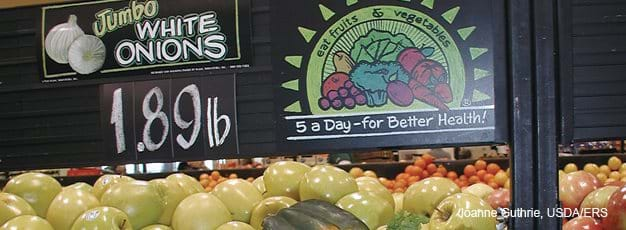Market Share Affects Price Differences Between Discount and Traditional Food Retailers

Variation in food prices is central to explaining differences in the affordability of food across the U.S. In a recent ERS study, researchers found that differences in prices at traditional versus discount (nontraditional) food retailers were smaller in areas where nontraditional food retailers had large market shares.
Nontraditional food retailers, including supercenters, mass merchandisers, wholesale club stores, and dollar stores, have made substantial gains in their share of the retail food market. Consumers now spend almost 28 percent of their food-at-home dollars at nontraditional stores. In previous studies, ERS researchers found that prices in the U.S. for 20 food categories were, on average, 20 percent lower in nontraditional stores than in supermarkets.
But do national price differences reflect the reality consumers face within a specific geographic market? ERS examined price differences between nontraditional and traditional stores in six metro areas using 2004-06 Nielsen Homescan data to determine if market-level results differ from national results. In the six metro areas, nontraditional stores had market shares varying from 8 to 30 percent.
Both broad categories, such as low-fat yogurt, and brand-specific items, such as Yoplait yogurt, were compared from four major food groups—dairy, meat, fruit and vegetables, and grains. Researchers used a statistical model to remove the effects of other factors that may influence average prices paid, such as season and household income, size, and race.
The two markets with the lowest nontraditional market shares—Philadelphia and New York—together had an average discount of 12.5 percent for broad categories and 12 percent for brand items. Price differences between traditional and nontraditional stores were smaller and less frequent in Atlanta and San Antonio—markets where overall average food prices were lowest and nontraditional retailers had the highest market shares of the six metro areas. The average price discount in nontraditional stores was 6 percent for broad categories and 4 to 7 percent at the brand level.
Smaller price differences between store types may be attributed to some higher priced traditional retailers exiting the market in which nontraditional retailers gain a large market share and the remaining traditional retailers lowering prices in response to increased competition from the nontraditional stores. Such a response would result in a decrease in overall average food prices. Alternatively, the smaller differences could be due to nontraditional retailers raising prices once they have a large enough market share to do so. Since markets with the largest and growing nontraditional market share continue to have lower average prices as compared with other cities, the first possibility seems more likely.
This analysis implies that the influence of competition from nontraditional retailers must be considered in the design of policies intended to improve food access and food choices.
| Market | Consumer food expenditure shares at nontraditional stores (percent) | Average price discount - broad category (percent) |
Average price discount - brand-level (percent) |
|---|---|---|---|
| Atlanta | 30 | 6 | 7 |
| San Antonio | 22 | 6 | 4 |
| Baltimore/DC | 19 | 16 | 10 |
| Chicago | 15 | 9 | 11 |
| Philadelphia | 12 | 10 | 9 |
| New York | 8 | 15 | 15 |
| Total U.S. | 24 | 12 | 13 |
| Source: USDA, Economic Research Service using 2004-06 Nielsen Homescan data. | |||
How Much Lower Are Prices at Discount Stores? An Examination of Retail Food Prices, by Ephraim Leibtag, Catherine Barker, and Paula Dutko, USDA, Economic Research Service, October 2010

